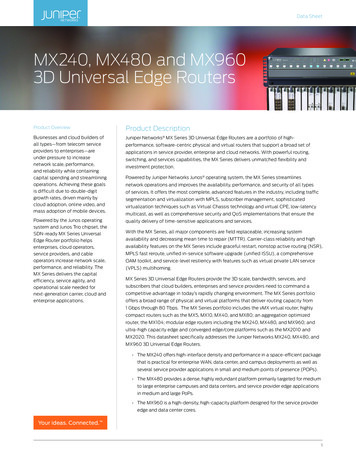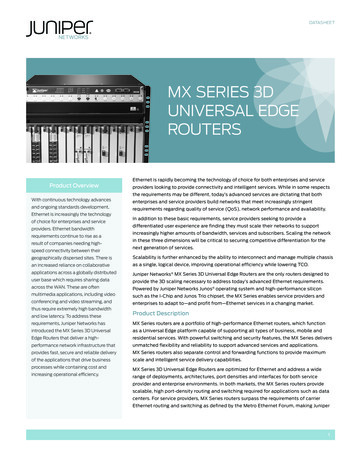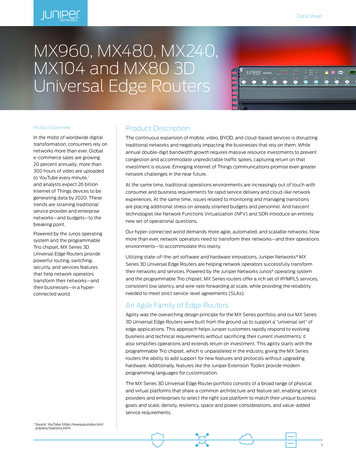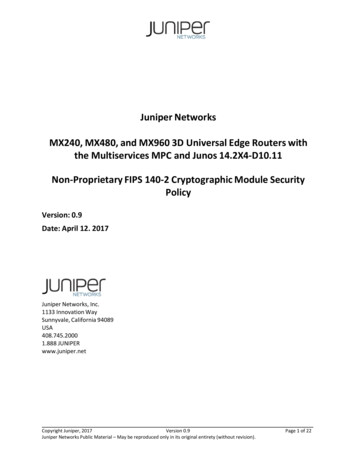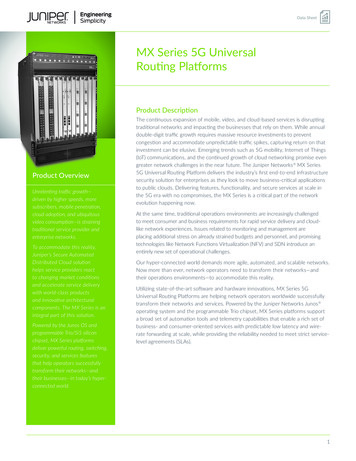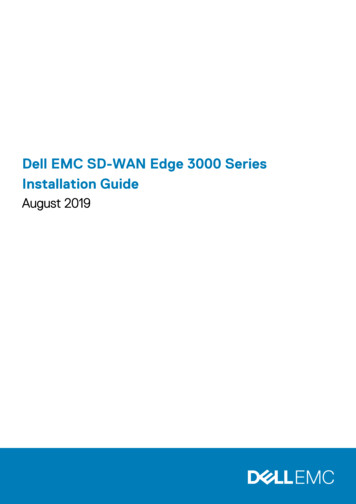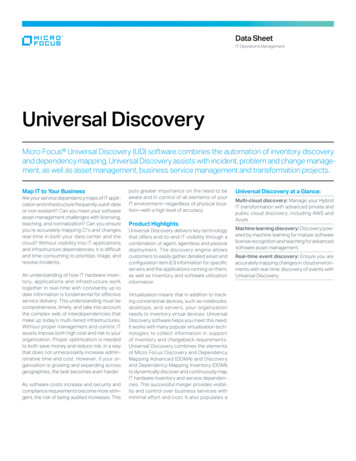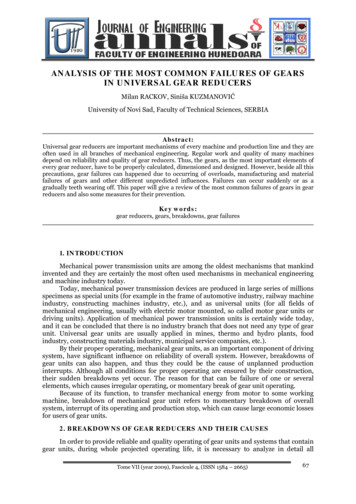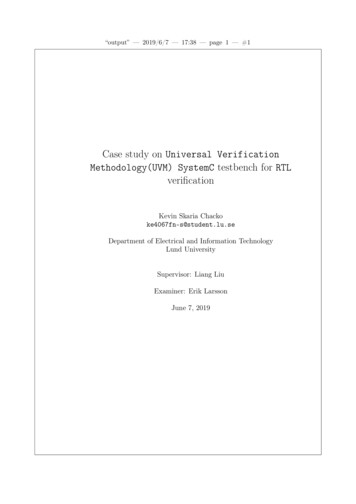
Transcription
Data SheetMX Series 3D UniversalEdge RoutersProduct OverviewProduct DescriptionIn the midst of worldwide digitalThe continuous expansion of mobile, video, and cloud-based services is disruptingtransformation, unrelenting traffictraditional networks and impacting the businesses that rely on them. While annual double-growth—driven by higher accessdigit traffic growth requires massive resource investments to prevent congestion andspeeds, increased subscriberaccommodate unpredictable traffic spikes, capturing return on that investment can beadoption, mobile penetration,and cloud adoption, as well asubiquitous video consumption—elusive. Emerging Internet of Things (IoT) communications promise even greater networkchallenges in the near future.is straining traditional serviceAt the same time, traditional operations environments are increasingly challenged to meetprovider and enterprise networksconsumer and business requirements for rapid service delivery and cloud-like networkto the breaking point. Networkexperiences. Issues related to monitoring and management are placing additional stress onoperators need to transformalready strained budgets and personnel, and promising technologies like Network Functionstheir networks and operationsenvironments to accommodateVirtualization (NFV) and SDN introduce an entirely new set of operational challenges.this reality.Our hyper-connected world demands more agile, automated, and scalable networks. NowPowered by the Junos OS and themore than ever, network operators need to transform their networks—and their operationsprogrammable Trio chipset, MXenvironments—to accommodate this reality.Series routers provide powerfulrouting, switching, security,and services features that helpnetwork operators successfullytransform their networks—andUtilizing state-of-the-art software and hardware innovations, Juniper Networks MX Series3D Universal Edge Routers are helping network operators worldwide successfully transformtheir networks and services. Powered by the Juniper Networks Junos operating systemand the programmable Trio chipset, MX Series routers support a broad set of automationtheir businesses—to thrive intools and telemetry capabilities that enable a rich set of business- and consumer-orientedtoday’s hyper-connected world.services with predictable low latency and wire-rate forwarding at scale, while providing thereliability needed to meet strict service-level agreements (SLAs).An Agile Family of Edge RoutersThe MX Series portfolio was designed for agility and built from the ground up to support auniversal set of edge applications. This approach helps Juniper customers rapidly respond toevolving business and technical requirements while simplifying operations without sacrificingtheir current infrastructure investments. This agility starts with the programmable Triochipset, which enables MX Series routers to flexibly add support for new features, such astelemetry, without costly hardware upgrades. Additionally, support for the Junos AutomationToolkit and the Juniper Extension Toolkit provide modern programming languages thatreduce costs and increase profitability by improving productivity and customization.1
MX Series 3D Universal Edge RoutersThis agility is evident in the wide variety of MX Series usecases that have been proven in the world’s largest and mostdemanding networks, including: Business Edge: MX Series routers support the broadestData SheetAt-a-Glance: MX Series 3D Universal EdgeRouters ComparisonThe MX Series portfolio includes a wide range of physical andvirtual platforms that share a common architecture and featurerange of L2/L2.5/L3 VPN services which, in combinationset. This enables Juniper customers to select the platform thatwith multilayer, multiprotocol resiliency, ensure thatbest addresses their unique business goals and satisfies theircustomer SLAs are met under all network conditions.scale, density, resiliency, space, power, and value-added service Internet/Peering Gateway: MX Series routers support the highperformance, reliability, scale, and density needed to efficientlypeer with Internet and other service provider networks. Broadband Network Gateway (BNG): MX Series routersrequirements without compromising on quality or features.Modular MX Series RoutersMX960, MX480, and MX240 3D Universal Edge Routers aremodular, chassis-based routers.offer the highest subscriber density and most sophisticatedbroadband edge features available in the industry. Universal SDN Gateway: The MX Series offers acomprehensive solution for interconnecting virtualand physical networks—as well as between virtualnetworks operating with different technologies—viasupport for Multiprotocol BGP (MBGP), dynamic tunnels The MX960 has been proven in the world’s largest serviceprovider, cable, mobile, and data center networks, offering10.56 Tbps of system capacity in support of business andresidential broadband services as well as peering andprovider edge applications. The MX480 is a modular, 5.76 Tbps-capable routerusing MPLSoGRE or Virtual Extensible LAN (VXLAN)that supports a wide range of cloud, campus, enterprise,encapsulation, virtual routing and forwarding (VRF) tables,data center, service provider, cable, and mobile serviceE-VPNs, and Network Configuration Protocol (NETCONF),core applications.along with the ability to send traffic between VRF andglobal routing tables based on configuration and policy. Data Center and Cloud Edge: The MX Series is ideal for datacenter/cloud edge applications, with support for multipleoverlay encapsulation methods, including VXLAN, NetworkVirtualization using Generic Routing Encapsulation (NVGRE),MPLSoUDP, MPLSoGRE, 802.1BR, SR-MPLS, and SR-V6. Enterprise WAN: Enterprises and government agenciesworldwide use MX Series routers to build their ownoverlay network on top of a service provider’s Layer 2 orMPLS network, using encapsulation technologies such asMPLSoGRE, VXLAN, and IPsec for secure transport. Universal Metro/Aggregation: MX Series routers offer a The MX240 is a compact router ideal for space-constrainedcloud, enterprise, data center, service provider, cable, andmobile service core deployments.Fixed-Configuration MX Series RoutersMX204, MX150, MX104, MX80, MX40, MX10, and MX5 3DUniversal Edge Routers are fixed-configuration routers thatsupport modular interfaces. The MX204 is a space- and power-optimized routerdelivering ultra-high port density and throughput whileconsuming just 0.9 W/Gb. It addresses the emerging edgeand metro Ethernet networking needs of service providers,mobile, web-scale operators, and MSOs by delivering 800Gbps of throughput in support of high-density 100GbE,full suite of routing and switching features, allowing you to40GbE, and discrete and breakout 10GbE and 1GbEchoose a deployment model that best fits your businessinterfaces—all in a single rack unit.and technical needs. The MX Series can be deployed asIP/IP VPN edge routers, Ethernet VPN (EVPN) and virtualprivate LAN service (VPLS) provider edge (VPLS-PE)routers, MPLS label-switching (LSR) routers, and as Layer 2Ethernet switches or Layer 3 IP routers. Mobile Backhaul: In addition to switching, routing, andsecurity features, MX Series routers support highly scalableand reliable hardware-based timing that meets thestrictest LTE requirements, including Synchronous Ethernetfor frequency and the Precision Time Protocol (PTP) forfrequency and phase synchronization. In addition, the MX104is ETSI 300-compliant for deployment in mobile applications. The MX150 is a compact, full-featured router that supports1GbE and 10GbE interfaces. It provides a cost-effectivesolution for a wide range of low-bandwidth provider edge,business edge, broadband network gateway (BNG), andenterprise WAN applications. The MX104 is a mobile backhaul-optimized, ETSI 300 mmcompliant chassis with high redundancy and 160 Gbps ofthroughput. The MX104 offers four MIC slots and redundantfixed 10GbE interfaces for flexible network connectivity. The MX80, MX40, MX10, and MX5 are software upgradeablefrom 40 Gbps to 160 Gbps, enabling cost-effective “payas you grow” scale. These routers have up to four ModularInterface Card (MIC) slots and two fixed 10GbE interfaces forconnecting to the network.The following table provides a comparison between the variousMX Series modular and fixed-configuration platforms.2
MX Series 3D Universal Edge RoutersData SheetTable 1: MX Series 3D Universal Edge Routers at a GlanceRack unitsSystems per 685113.522223694848132424242411 MPCs6 MPCs2 MPCs8 10GbE,4 100GbENA4 10GbE,4 MICslots4 10GbE,31 MICslots2 10GbE,32 MICslots33 MICslots34 MICslotsPer slot capacity480 Gbps480 Gbps480 GbpsNANA20 Gbps20 Gbps20 Gbps20 Gbps20 GbpsMaximum systemthroughput510.56Tbps5.76 Tbps1.92 Tbps800 Gbps40 Gbps160 Gbps160 Gbps120 Gbps80 Gbps40 esNANAYesYesYesYesNAMaximum 1GbE4402408024128080604020Maximum 10GbE440240802428841NAMaximum 40GbE13272244NANANANANANASlotsMaximum 100GbE442484NANANANANANA10GbE DWDM884816NANANANANANANA100GbE DWDM22124NANANANANANANAThe MX80 has two front MIC slots and one rear MIC slot. The rear MIC slot only supports the MS-MIC.The MX40 has two front MIC slots and one rear MIC slot. The rear MIC slot only supports the MS-MIC.The MX10 has two front MIC slots and one rear MIC slot. The rear MIC slot only supports the MS-MIC.4The MX5 has one front MIC slot and one rear MIC slot. The rear MIC slot only supports the MS-MIC.5Note, system throughput is calculated as (per slot capacity) x (number of slots) x (2).123Architecture and Key ComponentsJunos OSModular Components for Chassis-based MX SeriesRoutersJunos OS is a reliable, high-performance, modular networkThe modular, chassis-based MX960, MX480, and MX240 sharethe following components:operating system that is supported across all of Juniper’s physicaland virtual routing, switching, and security platforms. Junos OSimproves network operations and increases service availability,performance, and security with features like low-latency Modular Port Concentrators (MPCs) provide routing, MPLS,multicast, comprehensive quality of service (QoS), unified in-switching, inline services, subscriber management, andservice software upgrade (unified ISSU), and Junos Continuity,hierarchical quality of service (HQoS) among many otherwhich eliminates the risk and complexity of OS upgrades. Withfeatures. MPCs may also host interfaces directly or viasecure programming interfaces, versatile scripting support, andModular Interface Cards (MICs) that allow users to “mix andintegration with popular orchestration frameworks, Junos OSmatch” interface types. Powered by the programmable Triooffers flexible options for DevOps style management that canchipset, MPCs collect and stream telemetry that identifiesunlock more value from the network.resource utilization, loss and delay, and other metrics. Switch Control Boards (SCBs) feature an integratedswitch fabric that connects to all slots in the chassis ina nonblocking architecture. The SCBs house the RoutingEngine, control power to MPCs, monitor and control systemfunctions such as fan speed and the system front panel,and manage clocking, resets, and boots. The Routing Engine (RE) provides the control plane, runsThe Programmable Trio ChipsetThe programmable Trio chipset is Juniper-developed breakthroughsilicon technology that is implemented across the MX Seriesportfolio. Its innovative design improves business economics byenabling a truly converged platform with maximum performance,service agility, and exceptional power and thermal efficiency.Trio has a programmable forwarding data structure that allowsJuniper Networks Junos operating system, and handlesfast microcode changes in the hardware itself, as well as aall routing protocol processes as well as the softwareprogrammable lookup engine that allows inline service processing.processes that control MPCs, chassis components,Furthermore, Trio’s programmable QoS engine supports coarsesystem management, and user access to the router. REsand fine-grained queuing to efficiently address the diversecommunicate with MPCs via dedicated out-of-bandrequirements of core, edge, and aggregation use cases.management channels.With its proven extensibility and agility, the programmable Trio chipset helps network operators worldwide successfully addresstheir most complex technical and market challenges, andpromises to meet the requirements of emerging applications formany years to come.3
MX Series 3D Universal Edge RoutersData SheetNetwork Edge Services MPCs support inline services using the programmable TrioMX Series routers can host optionally licensed Junos OS-basedchipset; supported services include flow monitoring, 1:1network edge services at scale, both inline on MPCs as well as onNetwork Address Translation (NAT), port mirroring, genericdedicated service cards. Hosting network edge services on MXrouting encapsulation (GRE), IP tunneling, logical tunnels,Series routers reduces network cost and complexity by eliminatinglawful intercept, and video monitoring. The MS-MPC and the MS-MIC provide dedicated processingnumerous elements, operating systems, and interconnections.for compute-intensive services such as carrier-grade NAT(CGNAT), IPsec, stateful firewall, deep packet inspection,flow monitoring, and load balancing.MX Series Platform/Feature MatrixSecurityInlineServicesService rewall 3DDoS—FlowSpec3333333333Stateless filtersL2-L43333333333Stateful services63333No33333GRE reassembly33333333331:1 NAT3333333333Flow monitoring3333333333Video monitoring3333No33333Lawful intercept3333333333Mirroring3333333333Deep Flow monitoring3333No33333Traffic loadbalancing333NoNoNoNoNoNoNoIPsec333NoNo
MX960, MX480, and MX240 3D Universal Edge Routers are modular, chassis-based routers. The MX960 has been proven in the world’s largest service provider, cable File Size: 1MBPage Count: 14
